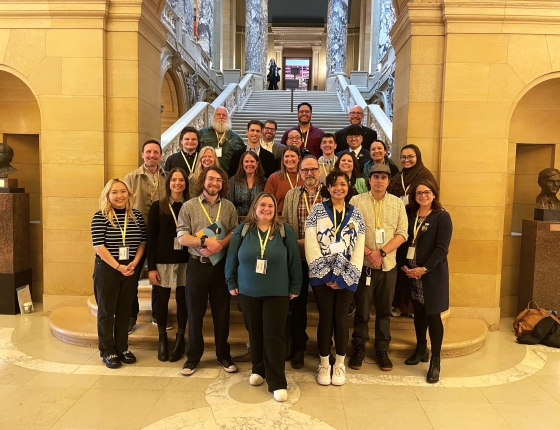The 2025 Minnesota legislative session began with unprecedented tension and political maneuvering, which set the stage for a historic and contentious year at the Capitol.
Despite the challenging political dynamics, CEE helped pass a nation-leading community benefits program to fund low-income weatherization programs statewide through a special fee on data centers.
It was only the second time in state history that the House was evenly split between Democrats and Republicans (67–67) — an exact partisan tie that created immediate uncertainty. That balance was quickly upended when a court decision vacated a DFL-held seat, giving Republicans a sudden and narrow contested majority in the House.
In response, the DFL took the extraordinary step of refusing to attend floor sessions, asking for a special election to fill the vacancy before any legislative work could move forward. After the Minnesota Supreme Court ruled in favor of the DFL on the contested GOP majority, the two parties were able to work out an agreement to start their work in earnest.
Meanwhile, the Senate sadly saw the passing of Senator Dziedzic to cancer, which created a temporary tie in that body, but was less contentious than the House and a power-sharing agreement came together quickly.
The process was even more fraught due to the February forecast that projected a minimal surplus of $456 million for the 2026–2027 biennium, a decrease from the previous estimate in November 2024. However, the bigger problem facing the state is the nearly $6 billion projected deficit in the 2028–2029 biennium, which is attributed to higher inflation and increased spending that is outpacing revenue growth. Because of this forecast, the legislature in this budget cycle needed to cut and curb spending in many jurisdictions.
With those unprecedented obstacles, the opening days reflected the deep partisan divides and signaled what ultimately was a rocky end of session. While priorities and possibilities shifted throughout, CEE’s policy team stayed nimble to maintain realistic session goals that would contribute to our longer-term vision for a sustainable and cost-effective energy system for the state.
This year, CEE followed bills in the Energy and Bonding Committees.
In the Energy Committee, CEE followed and supported the budget bill that provided the operational increase to both the Department of Energy Resources and the Public Utilities Commission. These were important increases that the two entities needed to fulfill their duties in a timely and robust manner. The budget bill also contained non-controversial policy language modernizing the energy statutes, creating a securitization program for utilities in case of extraordinary weather events and decoupling LiHEAP from federal programing. You can read the bill here.
The Energy Committee also took on the emerging issue of data centers and their impact on the grid and ratepayers. Last summer, CEE was asked to provide input and research on data center impacts and building efficiency by Chair Acomb. During that policy research, we found that data centers committed to weatherization and community benefit programs in other states to help offset grid impacts along with supporting the communities in which they operate. In collaboration with stakeholders, CEE worked to develop ratepayer protections, a Clean Energy Tariff, environmental protections, and create a new data center funded weatherization program for low-income homes statewide within ECO.
The community benefits program that CEE advocated for is a one-of-a-kind, nation-leading commitment by large-scale data centers to invest in weatherization. The program requires them to pay, depending on size, $2M–$5M a year in exchange for regulatory certainty.
Minnesota has approximately 290,000 households with an income of 80% area median income or below that still require weatherization, which at our current pace and investment level will take 130 years to complete. For low-income Minnesotans, a properly weatherized home could mean utility savings between $200–$400 per year. We believe this investment by the data centers could help those who need it most afford their utility bills, especially at a time when weatherization is being cut in the state budget and there is uncertainty at the federal level. You can read the full bill here.
In the Bonding Committee, CEE supported much-needed Sustainable Building 2030 (SB2030) programmatic updates to ensure it will run effectively and be properly funded, but unfortunately it was not included in the bonding bill. We will continue to engage with members and our partners at the University of Minnesota to ensure we are successful in the 2026 session.
The confusion and conflict of Minnesota’s 2025 legislative session underscored CEE’s core values and commitment to find energy solutions that strengthen the economy and improve the environment for all Minnesotans. We are proud of what we and our partners were able to accomplish despite a challenging session and will continue to seek solutions that ensure lower energy costs for residents, a sustainable grid, and a clear path to achieving the state’s ambitious climate goals. Political climates change and that’s why CEE’s consistency and nonpartisan, data-driven approach are critical to continue improving our homes, buildings, and communities.
